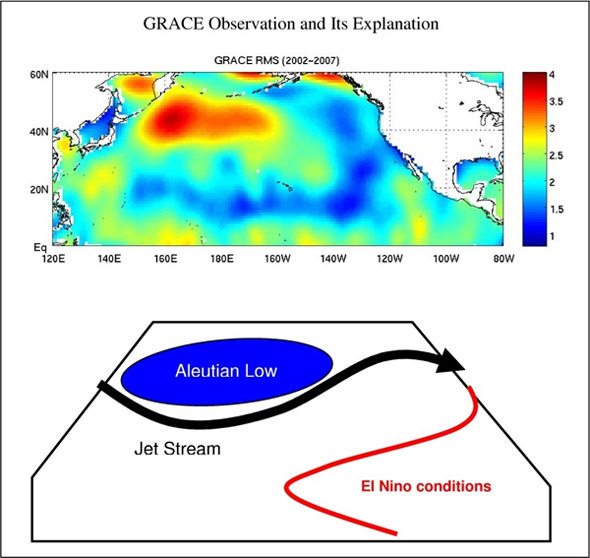News | March 2, 2009
Changes in Ocean Mass Linked to El Nino.

Caption: In the GRACE image of the North Pacific, red represents higher than normal ocean-bottom-pressure oscillation. Below: This diagram explains the ocean-atmosphere coupling that caused the oscillation.
El-Niño has long been known to be a joint phenomenon of the ocean and the atmosphere. Changes in surface atmospheric pressure between the eastern and western sides of the southern Pacific oscillate in conjunction with the changes in sea surface temperature in the tropics that characterize the El-Niño/Southern Oscillation (ENSO). A new study shows this link between the ocean and atmosphere is also reflected in ocean bottom pressure.
Using new data from NASA's twin GRACE satellites, JPL researchers Y. Tony Song and Victor Zlotnicki found a strong oscillation in ocean bottom pressure between the subpolar and subtropical gyres of the North Pacific, that takes place at the same time as the El Niño/Southern Oscillation.
By examining atmospheric circulation, sea surface altimetry data and an ocean circulation model, they confirmed that this change in ocean bottom pressure is the result of the El-Ni??o/Southern Oscillation, which deepens the Aleutian Low, the center of low atmospheric pressure in the northern Pacific, and alters the jet stream. This is the first time that changes in ocean mass, reflected in ocean bottom pressure, have been reported to be linked to ENSO events.
Their paper "Subpolar ocean bottom pressure oscillation and its links to the tropical ENSO" appears in the November 10, 2008, edition of the International Journal of Remote Sensing.
Subpolar ocean bottom pressure oscillation and its links to the tropical ENSO,
Song YT, Zlotnicki V,
INTERNATIONAL JOURNAL OF REMOTE SENSING, Vol: 29, Iss: 21,
Pages: 6091-6107, 2008.





